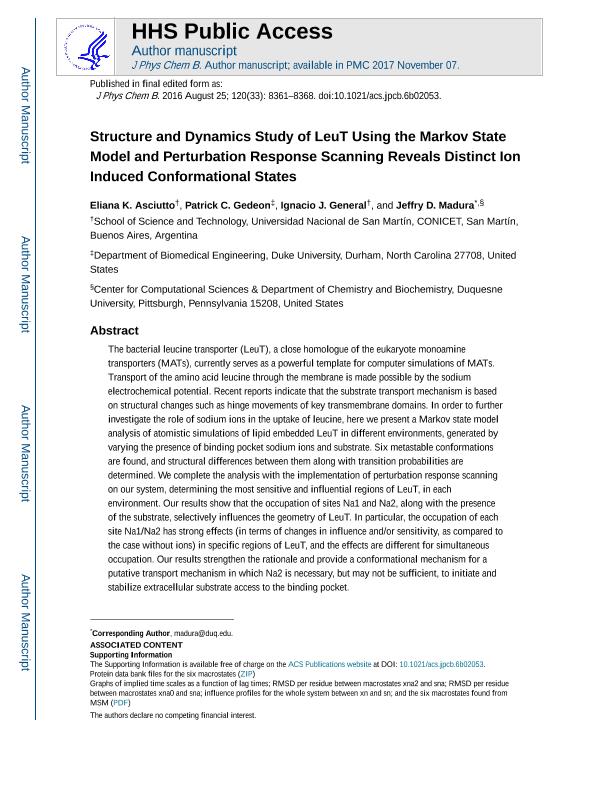Mostrar el registro sencillo del ítem
dc.contributor.author
Asciutto, Eliana Karina

dc.contributor.author
Gedeon, Patrick C.
dc.contributor.author
General, Ignacio

dc.contributor.author
Madura, Jeffry D.
dc.date.available
2018-05-31T15:20:26Z
dc.date.issued
2016-06
dc.identifier.citation
Asciutto, Eliana Karina; Gedeon, Patrick C.; General, Ignacio; Madura, Jeffry D.; Structure and Dynamics Study of LeuT Using the Markov State Model and Perturbation Response Scanning Reveals Distinct Ion Induced Conformational States; American Chemical Society; Journal of Physical Chemistry B; 120; 33; 6-2016; 8361-8368
dc.identifier.issn
1520-6106
dc.identifier.uri
http://hdl.handle.net/11336/46802
dc.description.abstract
The bacterial leucine transporter (LeuT), a close homologue of the eukaryote monoamine transporters (MATs), currently serves as a powerful template for computer simulations of MATs. Transport of the amino acid leucine through the membrane is made possible by the sodium electrochemical potential. Recent reports indicate that the substrate transport mechanism is based on structural changes such as hinge movements of key transmembrane domains. In order to further investigate the role of sodium ions in the uptake of leucine, here we present a Markov state model analysis of atomistic simulations of lipid embedded LeuT in different environments, generated by varying the presence of binding pocket sodium ions and substrate. Six metastable conformations are found, and structural differences between them along with transition probabilities are determined. We complete the analysis with the implementation of perturbation response scanning on our system, determining the most sensitive and influential regions of LeuT, in each environment. Our results show that the occupation of sites Na1 and Na2, along with the presence of the substrate, selectively influences the geometry of LeuT. In particular, the occupation of each site Na1/Na2 has strong effects (in terms of changes in influence and/or sensitivity, as compared to the case without ions) in specific regions of LeuT, and the effects are different for simultaneous occupation. Our results strengthen the rationale and provide a conformational mechanism for a putative transport mechanism in which Na2 is necessary, but may not be sufficient, to initiate and stabilize extracellular substrate access to the binding pocket.
dc.format
application/pdf
dc.language.iso
eng
dc.publisher
American Chemical Society

dc.rights
info:eu-repo/semantics/openAccess
dc.rights.uri
https://creativecommons.org/licenses/by-nc-sa/2.5/ar/
dc.subject
Leut
dc.subject
Ion Induced Conformational Change
dc.subject
Markov State Models
dc.subject
Perturbation Response Scanning
dc.subject.classification
Otras Ciencias Biológicas

dc.subject.classification
Ciencias Biológicas

dc.subject.classification
CIENCIAS NATURALES Y EXACTAS

dc.title
Structure and Dynamics Study of LeuT Using the Markov State Model and Perturbation Response Scanning Reveals Distinct Ion Induced Conformational States
dc.type
info:eu-repo/semantics/article
dc.type
info:ar-repo/semantics/artículo
dc.type
info:eu-repo/semantics/publishedVersion
dc.date.updated
2018-05-30T18:24:12Z
dc.journal.volume
120
dc.journal.number
33
dc.journal.pagination
8361-8368
dc.journal.pais
Estados Unidos

dc.description.fil
Fil: Asciutto, Eliana Karina. Universidad Nacional de San Martín. Escuela de Ciencia y Tecnología; Argentina. Consejo Nacional de Investigaciones Científicas y Técnicas; Argentina
dc.description.fil
Fil: Gedeon, Patrick C.. University of Duke; Estados Unidos
dc.description.fil
Fil: General, Ignacio. Universidad Nacional de San Martín. Escuela de Ciencia y Tecnología; Argentina. Consejo Nacional de Investigaciones Científicas y Técnicas; Argentina
dc.description.fil
Fil: Madura, Jeffry D.. Duquesne University; Estados Unidos
dc.journal.title
Journal of Physical Chemistry B

dc.relation.alternativeid
info:eu-repo/semantics/altIdentifier/doi/https://dx.doi.org/10.1021/acs.jpcb.6b02053
dc.relation.alternativeid
info:eu-repo/semantics/altIdentifier/url/https://pubs.acs.org/doi/10.1021/acs.jpcb.6b02053
dc.relation.alternativeid
info:eu-repo/semantics/altIdentifier/url/https://www.ncbi.nlm.nih.gov/pmc/articles/PMC5675527/
Archivos asociados
